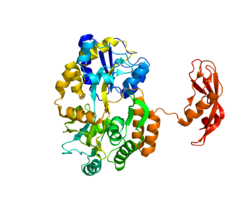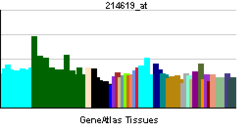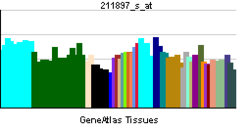- Corticotropin releasing hormone receptor 1
-
Corticotropin releasing hormone receptor 1 (CRHR1) is a protein, also known as CRF1, with the latter (CRF1) now being the IUPHAR-recommended name.[1] In humans, CRF1 is encoded by the CRHR1 gene.[2][3]
Contents
Function
The corticotropin-releasing hormone receptor binds to corticotropin-releasing hormone, a potent mediator of endocrine, autonomic, behavioral, and immune responses to stress.[4]
CRF1 receptors in mice mediate ethanol enhancement of GABAergic synaptic transmission. [5]
Clinical significance
Variations in the CRHR1 gene is associated with enhanced response to inhaled corticosteroid therapy in asthma.[6] CRF1 receptor antagonists are being actively studied as possible treatments for depression and anxiety.[7][8]
Interactions
Corticotropin releasing hormone receptor 1 has been shown to interact with Corticotropin-releasing hormone[9][10] and Urocortin.[11][10]
See also
- Corticotropin releasing hormone
- Corticotropin releasing hormone receptor
- Corticotropin releasing hormone antagonists
- Antalarmin
- Pexacerfont
References
- ^ Hauger RL, Grigoriadis DE, Dallman MF, Plotsky PM, Vale WW, Dautzenberg FM (March 2003). "International Union of Pharmacology. XXXVI. Current status of the nomenclature for receptors for corticotropin-releasing factor and their ligands". Pharmacol. Rev. 55 (1): 21–6. doi:10.1124/pr.55.1.3. PMID 12615952.
- ^ Polymeropoulos MH, Torres R, Yanovski JA, Chandrasekharappa SC, Ledbetter DH (July 1995). "The human corticotropin-releasing factor receptor (CRHR) gene maps to chromosome 17q12-q22". Genomics 28 (1): 123–4. doi:10.1006/geno.1995.1118. PMID 7590738.
- ^ Chen R, Lewis KA, Perrin MH, Vale WW (October 1993). "Expression cloning of a human corticotropin-releasing-factor receptor". Proc. Natl. Acad. Sci. U.S.A. 90 (19): 8967–71. doi:10.1073/pnas.90.19.8967. PMC 47482. PMID 7692441. http://www.pubmedcentral.nih.gov/articlerender.fcgi?tool=pmcentrez&artid=47482.
- ^ "Entrez Gene: CRHR1 corticotropin releasing hormone receptor 1". http://www.ncbi.nlm.nih.gov/sites/entrez?Db=gene&Cmd=ShowDetailView&TermToSearch=1394.
- ^ Nie Z, Schweitzer P, Roberts AJ, Madamba SG, Moore SD, Siggins GR (March 2004). "Ethanol augments GABAergic transmission in the central amygdala via CRF1 receptors". Science 303 (5663): 1512–4. doi:10.1126/science.1092550. PMID 15001778.
- ^ Tantisira KG, Lake S, Silverman ES, Palmer LJ, Lazarus R, Silverman EK, Liggett SB, Gelfand EW, Rosenwasser LJ, Richter B, Israel E, Wechsler M, Gabriel S, Altshuler D, Lander E, Drazen J, Weiss ST (July 2004). "Corticosteroid pharmacogenetics: association of sequence variants in CRHR1 with improved lung function in asthmatics treated with inhaled corticosteroids". Hum. Mol. Genet. 13 (13): 1353–9. doi:10.1093/hmg/ddh149. PMID 15128701.
- ^ Kehne JH (June 2007). "The CRF1 receptor, a novel target for the treatment of depression, anxiety, and stress-related disorders". CNS Neurol Disord Drug Targets 6 (3): 163–82. doi:10.2174/187152707780619344. PMID 17511614.
- ^ Ising M, Holsboer F (December 2007). "CRH-sub-1 receptor antagonists for the treatment of depression and anxiety". Exp Clin Psychopharmacol 15 (6): 519–28. doi:10.1037/1064-1297.15.6.519. PMID 18179304.
- ^ Grammatopoulos, D K; Dai Y, Randeva H S, Levine M A, Karteris E, Easton A J, Hillhouse E W (Dec. 1999). "A novel spliced variant of the type 1 corticotropin-releasing hormone receptor with a deletion in the seventh transmembrane domain present in the human pregnant term myometrium and fetal membranes". Mol. Endocrinol. (UNITED STATES) 13 (12): 2189–202. doi:10.1210/me.13.12.2189. ISSN 0888-8809. PMID 10598591.
- ^ a b Gottowik, J; Goetschy V, Henriot S, Kitas E, Fluhman B, Clerc R G, Moreau J L, Monsma F J, Kilpatrick G J (Oct. 1997). "Labelling of CRF1 and CRF2 receptors using the novel radioligand, [3H]-urocortin". Neuropharmacology (ENGLAND) 36 (10): 1439–46. doi:10.1016/S0028-3908(97)00098-1. ISSN 0028-3908. PMID 9423932.
- ^ Donaldson, C J; Sutton S W, Perrin M H, Corrigan A Z, Lewis K A, Rivier J E, Vaughan J M, Vale W W (May. 1996). "Cloning and characterization of human urocortin". Endocrinology (UNITED STATES) 137 (5): 2167–70. doi:10.1210/en.137.5.2167. ISSN 0013-7227. PMID 8612563.
Further reading
- Taché Y, Martinez V, Wang L, Million M (2004). "CRF1 receptor signaling pathways are involved in stress-related alterations of colonic function and viscerosensitivity: implications for irritable bowel syndrome". Br. J. Pharmacol. 141 (8): 1321–30. doi:10.1038/sj.bjp.0705760. PMC 1574904. PMID 15100165. http://www.pubmedcentral.nih.gov/articlerender.fcgi?tool=pmcentrez&artid=1574904.
- McLean M, Bisits A, Davies J, et al. (1995). "A placental clock controlling the length of human pregnancy". Nat. Med. 1 (5): 460–3. doi:10.1038/nm0595-460. PMID 7585095.
- Polymeropoulos MH, Torres R, Yanovski JA, et al. (1995). "The human corticotropin-releasing factor receptor (CRHR) gene maps to chromosome 17q12-q22". Genomics 28 (1): 123–4. doi:10.1006/geno.1995.1118. PMID 7590738.
- Chen R, Lewis KA, Perrin MH, Vale WW (1993). "Expression cloning of a human corticotropin-releasing-factor receptor". Proc. Natl. Acad. Sci. U.S.A. 90 (19): 8967–71. doi:10.1073/pnas.90.19.8967. PMC 47482. PMID 7692441. http://www.pubmedcentral.nih.gov/articlerender.fcgi?tool=pmcentrez&artid=47482.
- Ross PC, Kostas CM, Ramabhadran TV (1995). "A variant of the human corticotropin-releasing factor (CRF) receptor: cloning, expression and pharmacology". Biochem. Biophys. Res. Commun. 205 (3): 1836–42. doi:10.1006/bbrc.1994.2884. PMID 7811272.
- Opdenakker G, Fiten P, Nys G, et al. (1994). "The human MCP-3 gene (SCYA7): cloning, sequence analysis, and assignment to the C-C chemokine gene cluster on chromosome 17q11.2-q12". Genomics 21 (2): 403–8. doi:10.1006/geno.1994.1283. PMID 7916328.
- Vita N, Laurent P, Lefort S, et al. (1993). "Primary structure and functional expression of mouse pituitary and human brain corticotrophin releasing factor receptors". FEBS Lett. 335 (1): 1–5. doi:10.1016/0014-5793(93)80427-V. PMID 8243652.
- Donaldson CJ, Sutton SW, Perrin MH, et al. (1996). "Cloning and characterization of human urocortin". Endocrinology 137 (5): 2167–70. doi:10.1210/en.137.5.2167. PMID 8612563.
- Liaw CW, Grigoriadis DE, Lovenberg TW, et al. (1997). "Localization of ligand-binding domains of human corticotropin-releasing factor receptor: a chimeric receptor approach". Mol. Endocrinol. 11 (7): 980–5. doi:10.1210/me.11.7.980. PMID 9178757.
- Asakura H, Zwain IH, Yen SS (1997). "Expression of genes encoding corticotropin-releasing factor (CRF), type 1 CRF receptor, and CRF-binding protein and localization of the gene products in the human ovary". J. Clin. Endocrinol. Metab. 82 (8): 2720–5. doi:10.1210/jc.82.8.2720. PMID 9253360.
- Gottowik J, Goetschy V, Henriot S, et al. (1998). "Labelling of CRF1 and CRF2 receptors using the novel radioligand, [3H]-urocortin". Neuropharmacology 36 (10): 1439–46. doi:10.1016/S0028-3908(97)00098-1. PMID 9423932.
- Grammatopoulos D, Dai Y, Chen J, et al. (1998). "Human corticotropin-releasing hormone receptor: differences in subtype expression between pregnant and nonpregnant myometria". J. Clin. Endocrinol. Metab. 83 (7): 2539–44. doi:10.1210/jc.83.7.2539. PMID 9661640.
- Sakai K, Yamada M, Horiba N, et al. (1998). "The genomic organization of the human corticotropin-releasing factor type-1 receptor". Gene 219 (1–2): 125–30. doi:10.1016/S0378-1119(98)00322-9. PMID 9757017.
- Grammatopoulos DK, Dai Y, Randeva HS, et al. (2000). "A novel spliced variant of the type 1 corticotropin-releasing hormone receptor with a deletion in the seventh transmembrane domain present in the human pregnant term myometrium and fetal membranes". Mol. Endocrinol. 13 (12): 2189–202. doi:10.1210/me.13.12.2189. PMID 10598591.
- Lewis K, Li C, Perrin MH, et al. (2001). "Identification of urocortin III, an additional member of the corticotropin-releasing factor (CRF) family with high affinity for the CRF2 receptor". Proc. Natl. Acad. Sci. U.S.A. 98 (13): 7570–5. doi:10.1073/pnas.121165198. PMC 34709. PMID 11416224. http://www.pubmedcentral.nih.gov/articlerender.fcgi?tool=pmcentrez&artid=34709.
- Perrin MH, Fischer WH, Kunitake KS, et al. (2001). "Expression, purification, and characterization of a soluble form of the first extracellular domain of the human type 1 corticotropin releasing factor receptor". J. Biol. Chem. 276 (34): 31528–34. doi:10.1074/jbc.M101838200. PMID 11425856.
- Pisarchik A, Slominski AT (2002). "Alternative splicing of CRH-R1 receptors in human and mouse skin: identification of new variants and their differential expression". FASEB J. 15 (14): 2754–6. doi:10.1096/fj.01-0487fje. PMID 11606483.
- Graziani G, Tentori L, Portarena I, et al. (2002). "CRH inhibits cell growth of human endometrial adenocarcinoma cells via CRH-receptor 1-mediated activation of cAMP-PKA pathway". Endocrinology 143 (3): 807–13. doi:10.1210/en.143.3.807. PMID 11861501.
- Strausberg RL, Feingold EA, Grouse LH, et al. (2003). "Generation and initial analysis of more than 15,000 full-length human and mouse cDNA sequences". Proc. Natl. Acad. Sci. U.S.A. 99 (26): 16899–903. doi:10.1073/pnas.242603899. PMC 139241. PMID 12477932. http://www.pubmedcentral.nih.gov/articlerender.fcgi?tool=pmcentrez&artid=139241.
- King JS, Bishop GA (2003). "The distribution and cellular localization of CRF-R1 in the vermis of the postnatal mouse cerebellum". Exp. Neurol. 178 (2): 175–85. doi:10.1006/exnr.2002.8052. PMID 12504877.
External links
- IUPHAR GPCR Database - Corticotropin-releasing factor receptors
- "Corticotropin-releasing Factor Receptors: CRF1". IUPHAR Database of Receptors and Ion Channels. International Union of Basic and Clinical Pharmacology. http://www.iuphar-db.org/GPCR/ReceptorDisplayForward?receptorID=2914.
- MeSH Corticotropin-releasing+hormone+receptors
- MeSH CRF+receptor+type+1
Cell surface receptor: G protein-coupled receptors Class A:
Rhodopsin likeOtherMetabolites and
signaling moleculesOtherBile acid · Cannabinoid (CB1, CB2, GPR (18, 55, 119)) · EBI2 · Estrogen · Free fatty acid (1, 2, 3, 4) · Lactate · Lysophosphatidic acid (1, 2, 3, 4, 5, 6) · Lysophospholipid (1, 2, 3, 4, 5, 6, 7, 8) · Niacin (1, 2) · Oxoglutarate · PAF · Sphingosine-1-phosphate (1, 2, 3, 4, 5) · SuccinatePeptideOtherAnaphylatoxin (C3a, C5a) · Angiotensin (1, 2) · Apelin · Bombesin (BRS3, GRPR, NMBR) · Bradykinin (B1, B2) · Chemokine · Cholecystokinin (A, B) · Endothelin (A, B) · Formyl peptide (1, 2, 3) · FSH · Galanin (1, 2, 3) · GHB receptor · Gonadotropin-releasing hormone (1, 2) · Ghrelin · Kisspeptin · Luteinizing hormone/choriogonadotropin · MAS (1, 1L, D, E, F, G, X1, X2, X3, X4) · Melanocortin (1, 2, 3, 4, 5) · MCHR (1, 2) · Motilin · Opioid (Delta, Kappa, Mu, Nociceptin & Zeta, but not Sigma) · Orexin (1, 2) · Oxytocin · Prokineticin (1, 2) · Prolactin-releasing peptide · Relaxin (1, 2, 3, 4) · Somatostatin (1, 2, 3, 4, 5) · Tachykinin (1, 2, 3) · Thyrotropin · Thyrotropin-releasing hormone · Urotensin-II · Vasopressin (1A, 1B, 2)MiscellaneousGPR (1, 3, 4, 6, 12, 15, 17, 18, 19, 20, 21, 22, 23, 25, 26, 27, 31, 32, 33, 34, 35, 37, 39, 42, 44, 45, 50, 52, 55, 61, 62, 63, 65, 68, 75, 77, 78, 81, 82, 83, 84, 85, 87, 88, 92, 101, 103, 109A, 109B, 119, 120, 132, 135, 137B, 139, 141, 142, 146, 148, 149, 150, 151, 152, 153, 160, 161, 162, 171, 173, 174, 176, 177, 182, 183)OtherClass B: Secretin like OtherBrain-specific angiogenesis inhibitor (1, 2, 3) · Cadherin (1, 2, 3) · Calcitonin · CALCRL · CD97 · Corticotropin-releasing hormone (1, 2) · EMR (1, 2, 3) · Glucagon (GR, GIPR, GLP1R, GLP2R) · Growth hormone releasing hormone · PACAPR1 · GPR · Latrophilin (1, 2, 3, ELTD1) · Methuselah-like proteins · Parathyroid hormone (1, 2) · Secretin · Vasoactive intestinal peptide (1, 2)Class C: Metabotropic
glutamate / pheromoneOtherClass F:
Frizzled / SmoothenedFrizzledSmoothenedB trdu: iter (nrpl/grfl/cytl/horl), csrc (lgic, enzr, gprc, igsr, intg, nrpr/grfr/cytr), itra (adap, gbpr, mapk), calc, lipd; path (hedp, wntp, tgfp+mapp, notp, jakp, fsap, hipp, tlrp) Neuropeptidergics Cholecystokinin Agonists: Cholecystokinin • CCK-4
Antagonists: Asperlicin • Proglumide • Lorglumide • Devazepide • DexloxiglumideCRH CRF1Agonists: Corticotropin releasing hormoneGalanin Agonists: Galanin • Galanin-like peptide • Galmic • GalnonAgonists: Galanin • Galanin-like peptide • Galmic • GalnonAgonists: Galanin • Galmic • GalnonGhrelin MCH Agonists: Melanin concentrating hormone
Antagonists: ATC-0175 • GW-803,430 • NGD-4715 • SNAP-7941 • SNAP-94847Agonists: Melanin concentrating hormoneMelanocortin Agonists: alpha-MSH • Afamelanotide • Bremelanotide • Melanotan II
Antagonists: Agouti signalling peptideAgonists: alpha-MSH • Bremelanotide • Melanotan IIAgonists: alpha-MSH • Melanotan IINeuropeptide S Agonists: Neuropeptide S
Antagonists: SHA-68Neuropeptide Y Neurotensin Opioid see Template:OpioidsOrexin Oxytocin Agonists: Carbetocin • Demoxytocin • Oxytocin • WAY-267,464
Antagonists: Atosiban • Epelsiban • L-371,257 • L-368,899Tachykinin Agonists: Substance P
Antagonists: Aprepitant • Befetupitant • Casopitant • CI-1021 • CP-96,345 • CP-99,994 • CP-122,721 • Dapitant • Ezlopitant • FK-888 • Fosaprepitant • GR-203,040 • GW-597,599 • HSP-117 • L-733,060 • L-741,671 • L-743,310 • L-758,298 • Lanepitant • LY-306,740 • Maropitant • Netupitant • NKP-608 • Nolpitantium • Orvepitant • RP-67,580 • SDZ NKT 343 • Vestipitant • VofopitantVasopressin Agonists: Desmopressin • Felypressin • Ornipressin • Terlipressin • Vasopressin
Antagonists: Conivaptan • Demeclocycline • RelcovaptanAgonists: Felypressin • Ornipressin • Terlipressin • Vasopressin
Antagonists: Demeclocycline • NelivaptanAgonists: Desmopressin • Ornipressin • Vasopressin
Antagonists: Conivaptan • Demeclocycline • Lixivaptan • Mozavaptan • Satavaptan • Tolvaptan
This transmembrane receptor-related article is a stub. You can help Wikipedia by expanding it.




